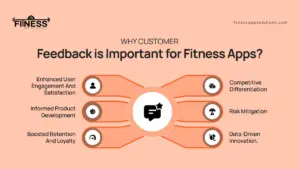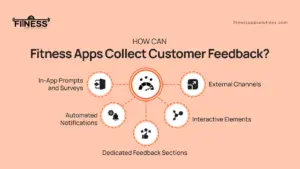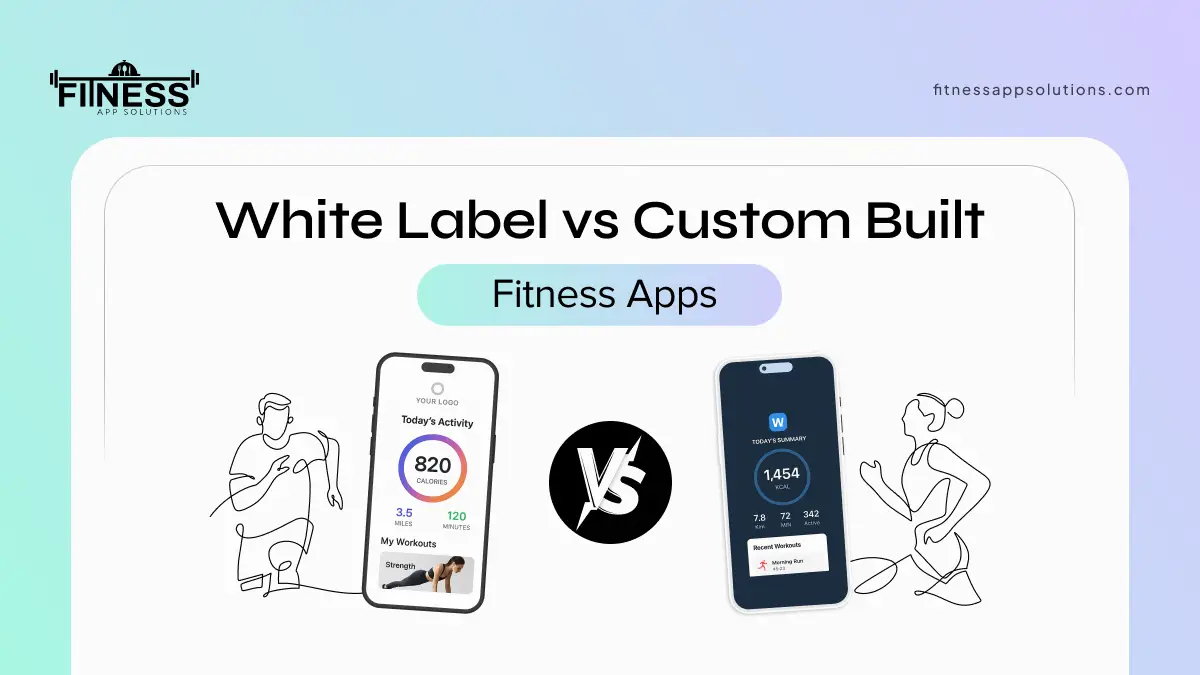To stand out in the competitive fitness app market, collecting and using customer feedback is key to enhancing user satisfaction and driving growth. This guide covers its importance, influencing factors, how to collect customer feedback, analysis techniques, and actionable steps, helping developers create more engaging apps.
Why Customer Feedback is Important for Fitness Apps?

Customer feedback is essential for fitness apps, offering insights into user experiences and enabling continuous improvement. It helps align features with needs, build trust, and foster innovation in a rapidly evolving industry.
Enhanced User Engagement and Satisfaction
Feedback helps identify what resonates with users, allowing for refinements that make interactions more enjoyable and intuitive, ultimately leading to higher daily active users and prolonged session times.
Informed Product Development
By highlighting gaps in features or content, feedback guides the creation of updates that address unmet needs, such as improved workout customization or better integration with wearable devices.
Boosted Retention and Loyalty
Addressing user concerns through feedback fosters a sense of value and care, reducing churn rates and encouraging long-term subscriptions by making users feel heard and prioritized.
Competitive Differentiation
Apps that actively incorporate feedback stand out by offering personalized experiences, setting them apart from generic alternatives, and attracting a dedicated user base.
Risk Mitigation
Early detection of issues, such as usability hurdles or performance lags, prevents negative reviews and reputational damage.
Data-Driven Innovation
Feedback provides qualitative and quantitative data that inspires new ideas, such as community features or advanced analytics, driving the app’s overall innovation pipeline.
What are the Common Factors Affecting Customer Feedback?
Customer feedback in fitness apps is influenced by various factors that affect its quality and quantity. Understanding these helps optimize collection and anticipate barriers for more effective insights.
1.App Design and Usability
The overall interface, including navigation ease and visual appeal, plays a significant role; a cluttered or confusing layout can lead to frustration, resulting in less detailed or more negative feedback.
2.User Experience and Expectations
How well the app meets individual goals, such as tracking progress or providing motivational content, affects feedback quality; unmet expectations often prompt more vocal responses.
3.Timing and Context
The moment feedback is solicited, such as during or after a session, can influence response rates and depth, with users more likely to share when experiences are fresh.
4.Motivational Drivers
Incentives or perceived benefits, like the promise of improvements, can encourage participation, while a lack of clear value might lead to apathy or low engagement.
5.Demographic and Behavioural Variables
Factors such as age, fitness level, or usage frequency shape feedback; for instance, experienced users might focus on advanced features, while novices emphasize basics.
6.Privacy and Trust Concerns
Users’ comfort with sharing personal data impacts openness; robust privacy assurances can enhance willingness to provide candid insights.
7.External Influences
Broader trends, such as social media buzz or competitor offerings, can colour perceptions and prompt comparative feedback, affecting the overall tone and focus.
How can Fitness Apps Collect Customer Feedback?

Collecting feedback requires diverse methods to ensure accessibility and relevance, allowing fitness apps to gather insights from various user segments and interaction points. Effective strategies prioritize user convenience, minimizing disruption to routines while encouraging consistent and varied input that reflects a broad range of experiences and preferences.
In-App Prompts and Surveys
Integrate simple, non-intrusive options like rating scales or short questionnaires directly within the app interface, allowing users to share thoughts immediately after key activities. This approach captures real-time sentiments, such as satisfaction with a workout session, and can include customizable question types to suit different feedback depths without requiring users to exit their workflow.
Automated Notifications:
Utilize push notifications or emails to request feedback at strategic intervals, such as following a completed workout or milestone achievement, to gather timely and contextual input. These can be personalized based on user behaviour, ensuring relevance and increasing response rates by aligning requests with moments of high engagement.
Dedicated Feedback Sections
Provide accessible portals within the app for users to submit detailed comments or suggestions, encouraging voluntary contributions without mandatory requirements. These sections can include text fields, voice notes, or multimedia uploads, fostering open-ended responses that reveal nuanced opinions on app features or overall experience.
Interactive Elements
Incorporate gamified or engaging features, such as feedback badges or rewards, to motivate participation and make the process enjoyable rather than obligatory. By adding elements like progress tracking for feedback submissions or virtual incentives, apps can transform routine input into an interactive experience that boosts motivation and long-term involvement.
External Channels
Leverage broader platforms for unsolicited feedback, including review sections or social media monitoring, to capture organic opinions from a wider audience. This method allows for passive collection of diverse viewpoints, such as public critiques or endorsements, which can complement in-app data and highlight external perceptions.
Follow-Up Mechanisms
Implement systems for clarifying or expanding on initial responses, such as follow-up questions, to deepen insights and ensure comprehensive data collection. These can involve automated sequences that probe further into specific topics, refining vague feedback into actionable details while maintaining user comfort and privacy.
How to Analyse the Customer Feedback and Act on It?
Analysing feedback involves organizing data to extract insights and drive changes. This process identifies patterns and ensures actions lead to measurable improvements.
Data Organization and Categorization
Sort feedback into themes, such as usability, content, or performance, using tools to group similar responses for easier interpretation and trend identification.
Sentiment and Trend Analysis
Evaluate the emotional tone of feedback to gauge overall satisfaction, while tracking recurring patterns over time to highlight systemic issues or emerging needs.
Prioritization Based on Impact
Assess feedback volume, user segments, and potential influence on key metrics like retention, assigning urgency to high-impact areas for focused attention.
Cross-Referencing with Metrics
Correlate feedback with app data, such as usage statistics or drop-off points, to validate insights and predict broader implications.
Development of Action Plans
Translate findings into specific, measurable initiatives, such as feature updates or bug fixes, with clear timelines and responsible teams.
Implementation and Communication
Roll out changes transparently, informing users about how their feedback led to improvements to reinforce trust and encourage future participation.
Monitoring and Iteration
Track the outcomes of actions through follow-up metrics and additional feedback cycles, refining approaches based on new data for ongoing optimization.
Conclusion
Collecting customer feedback is vital for fitness apps to adapt and innovate. By understanding its importance, factors, collection, and analysis, developers can enhance user experiences and achieve long-term success.
Embracing feedback as an ongoing process fosters a culture of continuous improvement, where apps evolve with user needs and stay ahead in a dynamic market. Ultimately, this approach not only boosts engagement and loyalty but also positions fitness apps as leaders in delivering personalized, effective wellness solutions.
Frequently Asked Questions (FAQs)
What tools can I use to collect feedback in a fitness app?
Various digital tools are available for integrating feedback mechanisms, such as survey builders, rating widgets, and analytics platforms that allow for seamless in–app collection without requiring extensive technical expertise.
How often should I collect feedback from users?
Feedback collection should be balanced to avoid overwhelming users, ideally occurring at natural touchpoints like after significant interactions, with frequency adjusted based on app updates or user activity levels to maintain relevance and response quality.
What are the best ways to analyse feedback data?
Effective analysis involves organizing data into categories, applying sentiment evaluation, and using visualization techniques to uncover patterns, ensuring that insights are both comprehensive and focused on actionable outcomes.
How can feedback improve user retention in fitness apps?
Feedback directly contributes to retention by enabling targeted improvements that address user pain points, enhance satisfaction, and build loyalty through demonstrated responsiveness to individual needs and preferences.
What challenges might I face when collecting feedback?
Common challenges include varying response rates due to user fatigue, ensuring data privacy to encourage honesty, and managing diverse feedback types, which can be mitigated by designing user-friendly processes and offering flexible participation options.


